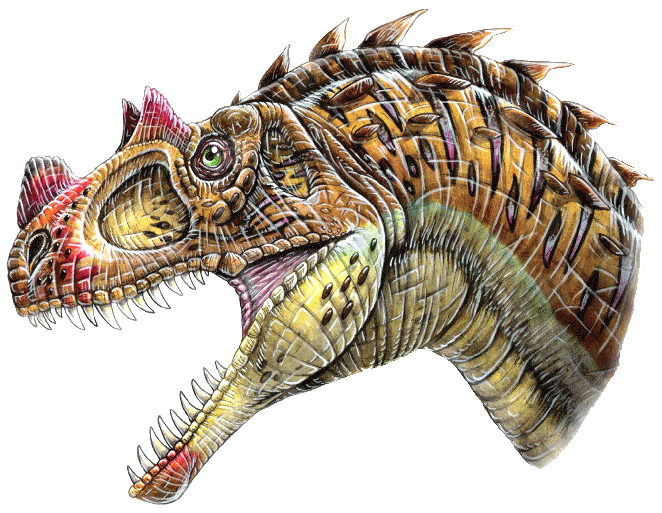|
Ceratosaurus nasicornis
(Marsh, 1884) |
|
 |
|
Name Means: |
"Horned Lizard" |
Length: |
20 feet (6 m) |
|
Pronounced: |
sair-AT-o-Saw-rus |
Weight: |
1 ton(1,000 kilos) |
|
When it lived: |
Late Jurassic - 150 MYA |
|
|
|
Where found: |
Colorado and Utah, USA; Africa |
|
|
|
Ceratosaurus was
a powerful predator that had large jaws and enormous, bladelike teeth.
The forelimbs were very strong, but also very short. They ended with
primitive four-fingered hands that had sharp claws. It walked on
its two hind legs. It had an S-shaped neck, a massive tail, a
bulky body, and heavy bones.
What makes it different and distinctive from other carnivores is
two short wing-shaped brow ridges above its eyes, on the top of the
head. It also had a large, bladelike horn on its snout.
It was of no apparent use in obtaining food, but may have been used in
courtship or to distinguish the sexes.
The first specimen was collected in 1883 by M.P. Felch in
Fremont County, Colorado The was the same quarry that yielded a
fine fossil skeleton of Allosaurus establishing that they
were contemporary. Ceratosaurus may have hunted in groups. If
so, then they could have ambushed even the very large sauropods. It
certainly competed with the giant predator Allosaurus for iguanodons,
stegosaurs, sauropods and other tasty meals.
Ceratosaurus was named in 1884 by paleontologist Othniel
C. Marsh. A large part of the skeleton was recovered which
provided which provided him with very good information with which to
describe another new type of theropod, which was both smaller and
clearly different from Allosaurus. Marsh theorized that
Ceratosaurus was a good swimmer, like the crocodilians (since it had a
long, thin tail). Since then, many Ceratosaurus fossils have been
found, in Colorado and Utah, USA, and in Tanzania, Africa.
The classification for Ceratosaurus is being reviewed and
questioned. It may be that this dinosaur is more closely
associated with Carnosauria that Ceratosaurian. An interesting footnote
is that the Nanotyrannus type specimen was thought to be a
Ceratosaurus when it was first being prepared. |
|
|
|
|
|
|
|
|
Edugraphics.Net | Feenixx Publishing |
|
|
|
|